Schneider Electric Bundle
Can Schneider Electric Continue Its Ascent in the Digital Age?
In a rapidly evolving landscape, Schneider Electric's strategic moves are reshaping the industrial automation and energy management sectors. The company's acquisition of AVEVA in early 2023, a pivotal step in its digital transformation journey, sets the stage for significant growth. This exploration delves into Schneider Electric's Schneider Electric SWOT Analysis, unveiling its ambitious plans for expansion and innovation.
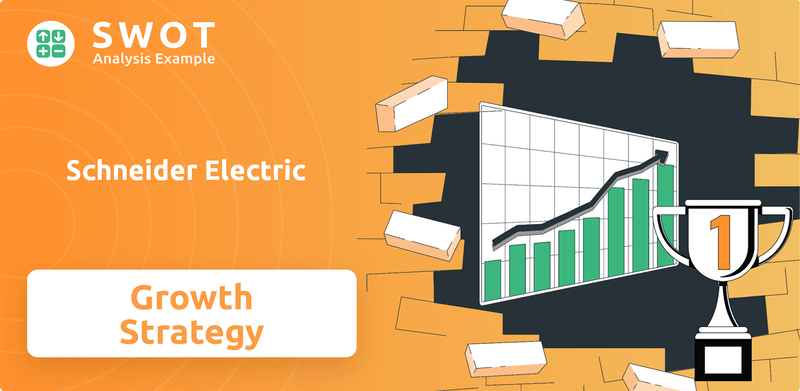
From its roots in the iron and steel industry, Schneider Electric has become a global leader in providing energy management solutions and industrial automation. This document offers a comprehensive Schneider Electric company analysis, examining its Schneider Electric growth strategy, future prospects, and its role in the industrial automation market. We will dissect its sustainable energy solutions, digital transformation strategy, and how it plans to navigate the competitive landscape, including its expansion plans in renewable energy, while also addressing the challenges and opportunities it faces in the coming years, including its impact on climate change.
How Is Schneider Electric Expanding Its Reach?
The expansion initiatives of Schneider Electric are designed to reinforce its market position and diversify its revenue streams. The company is actively pursuing a multi-faceted growth strategy, focusing on strategic acquisitions, geographic expansion, and new product launches. These efforts are geared towards capitalizing on the increasing demand for energy management and automation solutions, particularly in emerging markets and within the context of global sustainability trends.
A key aspect of Schneider Electric's strategy involves mergers and acquisitions. This approach enhances its capabilities and expands its market reach. Furthermore, the company's focus on geographic expansion, especially in high-growth regions, is a critical element of its long-term growth strategy. This includes investments in localized production and R&D facilities to better serve regional needs.
The company's commitment to sustainability and energy efficiency is evident in its product development and service offerings. By prioritizing solutions that align with global sustainability goals, Schneider Electric is positioned to capture significant market opportunities. This strategic alignment is essential for long-term success.
The acquisition of AVEVA in January 2023 significantly boosted Schneider Electric's software capabilities. This acquisition enhanced its offerings in industrial automation and digital transformation. The integration of AVEVA allows Schneider Electric to provide comprehensive end-to-end solutions, expanding its reach in the industrial software domain.
Schneider Electric is concentrating on emerging markets, particularly in Asia and the Middle East. These regions experience rapid urbanization and industrialization, driving demand for energy management and automation. The company invests in localized production and R&D to meet regional needs.
The company prioritizes offerings that support sustainability and energy efficiency. This includes smart grid solutions, intelligent building management systems, and renewable energy integration. EcoStruxure, its open, IoT-enabled system, is being deployed across sectors.
Schneider Electric collaborates with technology providers and academic institutions. These partnerships accelerate innovation and market penetration. These collaborations help to access new customer segments and strengthen existing relationships.
Schneider Electric's Schneider Electric growth strategy includes strategic acquisitions, geographic expansion, and new product launches, all aimed at driving long-term growth. The company is focusing on the industrial automation market and energy management solutions to capitalize on global trends. These initiatives are supported by strong financial performance and a commitment to innovation.
- Acquisition of AVEVA: This has enhanced software capabilities in industrial automation and digital transformation.
- Geographic Focus: Expansion in Asia and the Middle East to capitalize on rapid urbanization.
- Sustainability Initiatives: Prioritizing sustainable energy solutions, including smart grids and building management systems.
- Partnerships: Collaborating with technology providers and academic institutions to drive innovation.
The company's focus on emerging markets, coupled with its investment in sustainable solutions, positions it well for future growth. The company's expansion strategy is supported by a strong financial foundation, with revenue growth and profitability demonstrating the effectiveness of its approach. For further insights, consider exploring the Target Market of Schneider Electric.
Schneider Electric SWOT Analysis
- Complete SWOT Breakdown
- Fully Customizable
- Editable in Excel & Word
- Professional Formatting
- Investor-Ready Format
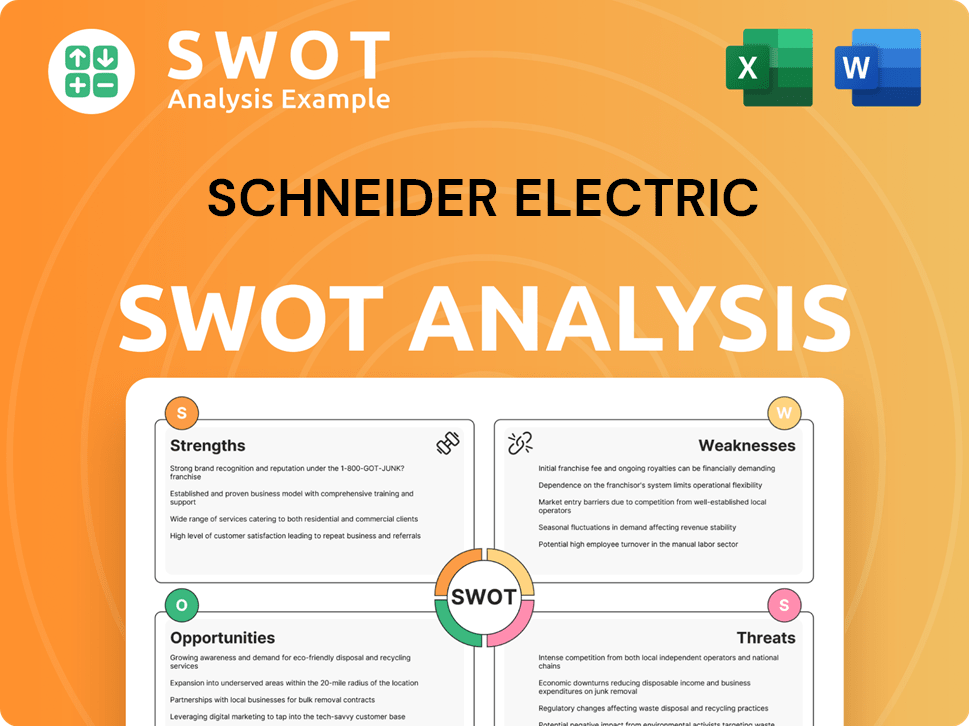
How Does Schneider Electric Invest in Innovation?
The core of the growth strategy lies in its commitment to innovation and technology. This approach is evident in the substantial investments in research and development (R&D) and a strong emphasis on digital transformation. This focus enables the company to create cutting-edge solutions and maintain a competitive edge in the market.
Schneider Electric's strategy involves a dual approach to innovation, combining in-house development with strategic collaborations. This method allows the company to leverage its internal expertise while also tapping into external innovations and agile development methodologies. This strategy ensures that the company remains at the forefront of technological advancements.
The company's digital transformation strategy centers around its EcoStruxure architecture, an open, interoperable, and IoT-enabled system. This system integrates advanced technologies like Artificial Intelligence (AI), the Internet of Things (IoT), and automation to enhance operational efficiency and sustainability. The integration of these technologies allows for predictive maintenance, optimized energy consumption, and real-time data analysis.
Schneider Electric allocated approximately €1.5 billion to R&D in 2023. This significant investment underscores the company's commitment to developing innovative solutions.
EcoStruxure is a key component of Schneider Electric's digital transformation strategy. It is designed to provide connected products, edge control, and apps, analytics, and services. This architecture supports the integration of advanced technologies.
Schneider Electric is heavily invested in sustainability initiatives. These initiatives aim to reduce carbon footprints and achieve energy efficiency goals. This includes innovations in microgrids and renewable energy management.
The company has introduced new AI-powered solutions for optimizing building energy performance. These solutions demonstrate Schneider Electric's leadership in applying advanced technologies to real-world challenges.
Schneider Electric consistently secures numerous patents annually. This reflects the company's continuous innovation efforts and its commitment to staying ahead in the market. The company's innovative approach is a key driver of its success.
The company has received industry accolades for its contributions to smart energy and automation. These recognitions highlight Schneider Electric's impact on the industry and its commitment to excellence. This recognition validates its strategic direction.
Schneider Electric's technology strategy focuses on several key areas to drive growth and meet market demands. The company leverages a combination of internal R&D and external collaborations to stay at the forefront of innovation, as discussed in the Marketing Strategy of Schneider Electric. This approach enables them to adapt quickly to market changes and customer needs.
- EcoStruxure Platform: This is a core component of the company's digital transformation strategy, providing an open and interoperable architecture for connected products, edge control, and cloud-based services.
- AI and Machine Learning: Used for predictive maintenance, energy optimization, and automation, enhancing efficiency and reducing operational costs.
- Internet of Things (IoT): Enables real-time data collection and analysis, improving decision-making and operational insights.
- Sustainability Solutions: Focus on microgrids, renewable energy management, and energy storage solutions to help customers reduce their carbon footprint and achieve energy efficiency goals.
- Automation Technologies: Including advanced control systems and software to improve operational efficiency and productivity in industrial and building applications.
Schneider Electric PESTLE Analysis
- Covers All 6 PESTLE Categories
- No Research Needed – Save Hours of Work
- Built by Experts, Trusted by Consultants
- Instant Download, Ready to Use
- 100% Editable, Fully Customizable
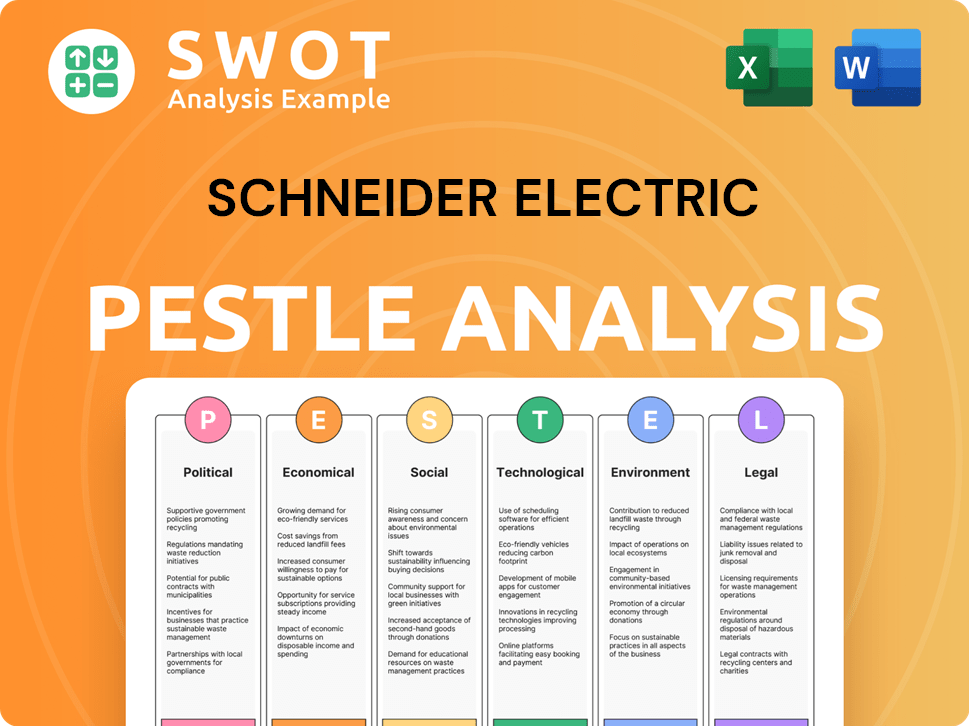
What Is Schneider Electric’s Growth Forecast?
The financial outlook for the company is robust, driven by its strategic focus on digitalization, sustainability, and industrial automation. The company's projections for 2024 indicate strong organic revenue growth, supported by sustained demand for energy management solutions and the increasing adoption of industrial automation technologies. This positive trajectory is further bolstered by significant investments in research and development, as well as strategic acquisitions that are expected to contribute positively to the company's earnings.
The company's commitment to sustainable growth is evident in its long-term financial goals, which emphasize mid-single-digit organic revenue growth and continuous improvement in profitability margins. The company's diversified portfolio and global presence have consistently enabled it to outperform industry benchmarks, demonstrating its ability to grow revenue and expand margins. The company's strong cash flow generation supports its investment plans and shareholder returns, providing ample liquidity for future growth initiatives.
The company's 2024 financial performance is expected to be strong, with an anticipated organic revenue growth of between 8% and 10%. This builds on a solid performance in 2023, where adjusted EBITA reached €6.4 billion. The company is targeting an adjusted EBITA margin of approximately 17.7% for 2024, reflecting healthy profitability. These figures underscore the company's financial health and its ability to capitalize on market opportunities.
The company's growth strategy centers on three key pillars: digitalization, sustainability, and industrial automation. These areas are crucial for driving future revenue and profit growth. The strategic focus is designed to capitalize on evolving market trends and customer needs.
The company's future prospects are promising, with strong growth expected in the energy management and industrial automation markets. The company's investments in R&D and strategic acquisitions, such as AVEVA, are expected to contribute to long-term value creation. The company is well-positioned to benefit from the global energy transition and the increasing demand for smart and sustainable solutions.
The company's energy management solutions are a key driver of its growth. These solutions are designed to improve energy efficiency and reduce carbon emissions. The company's products and services are essential for supporting the global energy transition and meeting sustainability goals.
The industrial automation market is another significant growth area for the company. The company's automation solutions help businesses improve efficiency, productivity, and safety. The increasing adoption of automation technologies is expected to drive substantial growth in this segment.
The company's financial performance is further supported by its strong cash flow generation. In 2023, free cash flow stood at €4.4 billion, providing the company with ample resources for future investments and shareholder returns. This financial strength underpins the company's strategic plans and enables it to fund expansion, innovation, and risk mitigation efforts. For further insights into the company's structure and financial health, consider reading about the Owners & Shareholders of Schneider Electric.
The company's business strategy for 2024 focuses on capitalizing on the growth in energy management and industrial automation. This involves strategic investments in R&D and acquisitions. The company aims to enhance its market position and expand its product portfolio.
The company holds a significant market share in both the energy management and industrial automation sectors. The company's competitive advantage stems from its innovative products, global presence, and strong customer relationships. The company continues to strengthen its market position through strategic initiatives.
The company's financial performance is consistently strong, with steady revenue growth and improving profitability margins. The company's ability to generate robust cash flows supports its investment plans and shareholder returns. The company's financial health is a key factor in its continued success.
The company is a leader in sustainable energy solutions, offering a wide range of products and services that support the global energy transition. These solutions help customers reduce their carbon footprint and improve energy efficiency. The company's commitment to sustainability drives innovation and growth.
The company operates in a competitive market, with key competitors including Siemens, ABB, and Eaton. The company differentiates itself through its innovative products, global reach, and customer-focused approach. The company's ability to adapt to market changes ensures its continued competitiveness.
The company is actively pursuing a digital transformation strategy to enhance its products and services. This involves leveraging technologies such as AI, IoT, and cloud computing. The digital transformation strategy is designed to improve operational efficiency and create new revenue streams.
Schneider Electric Business Model Canvas
- Complete 9-Block Business Model Canvas
- Effortlessly Communicate Your Business Strategy
- Investor-Ready BMC Format
- 100% Editable and Customizable
- Clear and Structured Layout
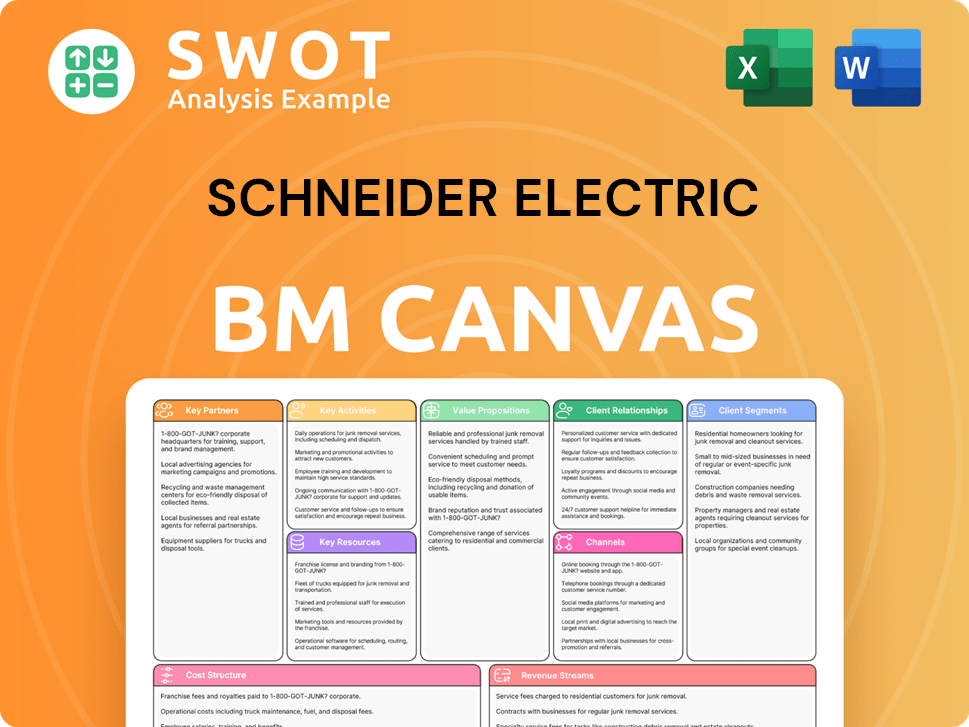
What Risks Could Slow Schneider Electric’s Growth?
The Schneider Electric growth strategy faces several potential risks and obstacles that could affect its future prospects. These challenges range from intense competition in the energy management and industrial automation markets to the rapid pace of technological advancements, demanding continuous innovation and significant investment in research and development.
Regulatory changes, particularly those related to environmental standards and data privacy, also pose potential hurdles, potentially impacting product development and market access. Additionally, supply chain vulnerabilities and internal resource constraints, such as securing skilled talent in areas like AI and cybersecurity, could impede the timely execution of strategic initiatives. The need for adaptability and robust risk management is crucial for navigating these complexities.
To mitigate these risks, the company employs a multi-pronged approach. This includes diversifying its product portfolio and geographical presence to reduce market-specific downturns and utilizing robust risk management frameworks, such as scenario planning, to prepare for potential disruptions. For more insights into the company's core values, consider reading about the Mission, Vision & Core Values of Schneider Electric.
The industrial automation market and energy management sectors are highly competitive, with established players and agile startups vying for market share. This intense competition requires continuous innovation, competitive pricing, and strong customer relationships to maintain and grow market presence. The need to differentiate products and services is crucial for sustained success.
The rapid advancement of technology necessitates continuous investment in research and development. Staying ahead requires significant capital expenditure and a focus on emerging technologies like AI, IoT, and advanced analytics. Failure to adapt quickly could result in obsolescence and loss of market share.
Evolving regulations, particularly in areas like environmental standards and data privacy, can affect product development and market access. Compliance with new standards may require significant investment and adjustments to business practices. Navigating these changes effectively is crucial for maintaining market competitiveness and avoiding penalties.
Global events, such as geopolitical tensions and pandemics, can disrupt production and delivery schedules. Diversifying the supply chain and increasing inventory levels for critical components are essential mitigation strategies. These disruptions can significantly impact revenue and profitability.
Securing skilled talent in specialized areas like AI and cybersecurity poses a challenge. Attracting and retaining qualified personnel requires competitive compensation and a strong company culture. Resource constraints can hinder the timely execution of strategic initiatives and limit innovation.
The increasing frequency and sophistication of cyberattacks pose a significant risk. Protecting intellectual property and customer data requires robust cybersecurity measures and continuous monitoring. The financial and reputational damage from a successful cyberattack can be substantial.
The company focuses on diversification of its product portfolio and geographical presence to reduce market-specific risks. They employ robust risk management frameworks, including scenario planning, to prepare for potential disruptions. Investment in regionalizing the supply chain and increasing inventory for critical components is also a key strategy.
Prioritizing cybersecurity is essential to protect intellectual property and customer data, particularly in the increasingly connected industrial landscape. The company invests in advanced cybersecurity measures and continuously monitors for potential threats. This helps safeguard its operations and maintain customer trust.
Schneider Electric Porter's Five Forces Analysis
- Covers All 5 Competitive Forces in Detail
- Structured for Consultants, Students, and Founders
- 100% Editable in Microsoft Word & Excel
- Instant Digital Download – Use Immediately
- Compatible with Mac & PC – Fully Unlocked
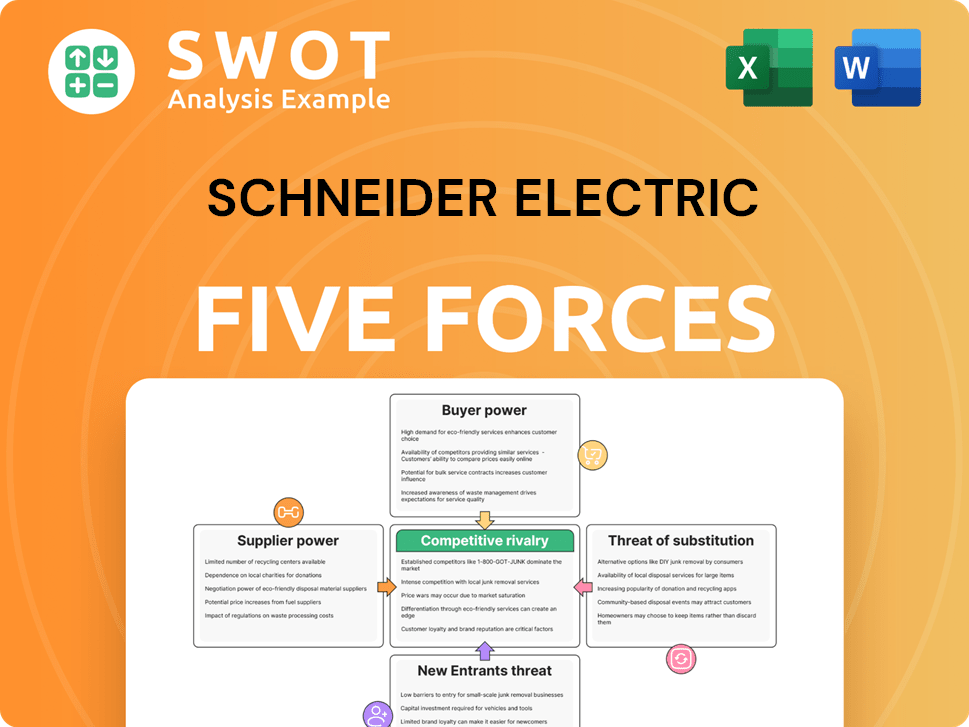
Related Blogs
- What are Mission Vision & Core Values of Schneider Electric Company?
- What is Competitive Landscape of Schneider Electric Company?
- How Does Schneider Electric Company Work?
- What is Sales and Marketing Strategy of Schneider Electric Company?
- What is Brief History of Schneider Electric Company?
- Who Owns Schneider Electric Company?
- What is Customer Demographics and Target Market of Schneider Electric Company?
Disclaimer
All information, articles, and product details provided on this website are for general informational and educational purposes only. We do not claim any ownership over, nor do we intend to infringe upon, any trademarks, copyrights, logos, brand names, or other intellectual property mentioned or depicted on this site. Such intellectual property remains the property of its respective owners, and any references here are made solely for identification or informational purposes, without implying any affiliation, endorsement, or partnership.
We make no representations or warranties, express or implied, regarding the accuracy, completeness, or suitability of any content or products presented. Nothing on this website should be construed as legal, tax, investment, financial, medical, or other professional advice. In addition, no part of this site—including articles or product references—constitutes a solicitation, recommendation, endorsement, advertisement, or offer to buy or sell any securities, franchises, or other financial instruments, particularly in jurisdictions where such activity would be unlawful.
All content is of a general nature and may not address the specific circumstances of any individual or entity. It is not a substitute for professional advice or services. Any actions you take based on the information provided here are strictly at your own risk. You accept full responsibility for any decisions or outcomes arising from your use of this website and agree to release us from any liability in connection with your use of, or reliance upon, the content or products found herein.